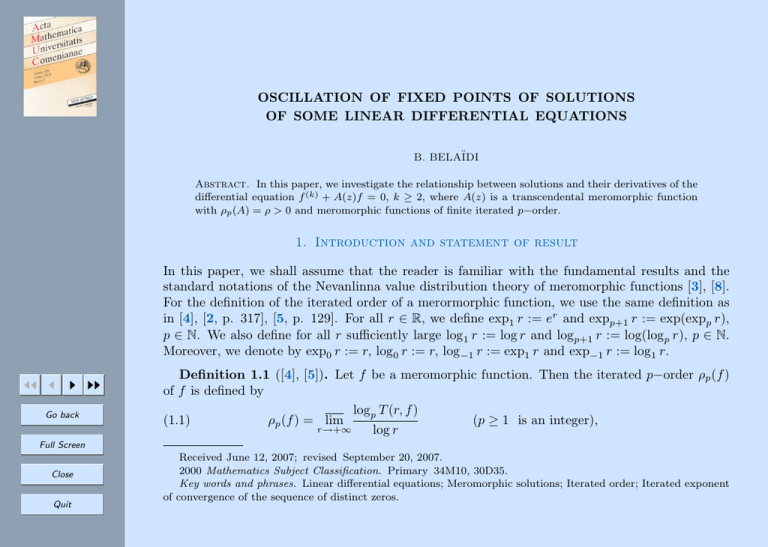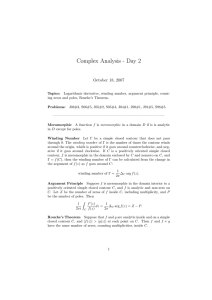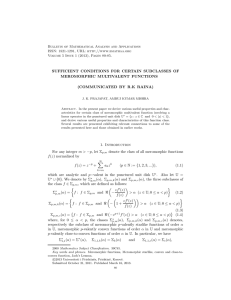OSCILLATION OF FIXED POINTS OF SOLUTIONS OF SOME LINEAR DIFFERENTIAL EQUATIONS
advertisement

OSCILLATION OF FIXED POINTS OF SOLUTIONS
OF SOME LINEAR DIFFERENTIAL EQUATIONS
B. BELAÏDI
Abstract. In this paper, we investigate the relationship between solutions and their derivatives of the
differential equation f (k) + A(z)f = 0, k ≥ 2, where A(z) is a transcendental meromorphic function
with ρp (A) = ρ > 0 and meromorphic functions of finite iterated p−order.
1. Introduction and statement of result
In this paper, we shall assume that the reader is familiar with the fundamental results and the
standard notations of the Nevanlinna value distribution theory of meromorphic functions [3], [8].
For the definition of the iterated order of a merormorphic function, we use the same definition as
in [4], [2, p. 317], [5, p. 129]. For all r ∈ R, we define exp1 r := er and expp+1 r := exp(expp r),
p ∈ N. We also define for all r sufficiently large log1 r := log r and logp+1 r := log(logp r), p ∈ N.
Moreover, we denote by exp0 r := r, log0 r := r, log−1 r := exp1 r and exp−1 r := log1 r.
JJ J
I II
Go back
Definition 1.1 ([4], [5]). Let f be a meromorphic function. Then the iterated p−order ρp (f )
of f is defined by
logp T (r, f )
(1.1)
ρp (f ) = lim
(p ≥ 1 is an integer),
r→+∞
log r
Full Screen
Close
Quit
Received June 12, 2007; revised September 20, 2007.
2000 Mathematics Subject Classification. Primary 34M10, 30D35.
Key words and phrases. Linear differential equations; Meromorphic solutions; Iterated order; Iterated exponent
of convergence of the sequence of distinct zeros.
where T (r, f ) is the Nevanlinna characteristic function of f (see [3], [8]). For p = 1, this notation
is called order and for p = 2 hyper-order.
Definition 1.2 ([4], [5]). The finiteness degree of the order of a meromorphic function f is
defined by
0,
for f rational,
min{j
∈
N
:
ρ
(f
)
<
+∞},
for f transcendental
j
for which some j ∈ N
(1.2)
i(f ) =
with ρj (f ) < +∞ exists,
+∞,
for f with ρj (f ) = +∞
for all j ∈ N.
Definition 1.3 ([4]). Let f be a meromorphic function. Then the iterated exponent of convergence of the sequence of distinct zeros of f (z) is defined by
(1.3)
JJ J
I II
Go back
Full Screen
λp (f ) = lim
r→+∞
logp N (r, f1 )
where N (r, f1 ) is the counting function of distinct zeros of f (z) in {|z| < r}. For p = 1, this
notation is called the exponent of convergence of the sequence of distinct zeros and for p = 2 the
hyper-exponent of convergence of the sequence of distinct zeros.
Definition 1.4 ([6]). Let f be a meromorphic function. Then the iterated exponent of convergence of the sequence of distinct fixed points of f (z) is defined by
Close
(1.4)
Quit
(p ≥ 1 is an integer),
log r
τ p (f ) = λp (f − z) = lim
r→+∞
1
logp N (r, f −z
)
log r
(p ≥ 1 is an integer).
For p = 1, this notation is called the exponent of convergence of the sequence of distinct fixed
points and for p = 2 the hyper-exponent of convergence of the sequence of distinct fixed points [7].
Thus τ p (f ) = λp (f − z) is an indication of oscillation of distinct fixed points of f (z).
For k ≥ 2, we consider the linear differential equation
f (k) + A(z)f = 0,
(1.5)
where A(z) is a transcendental meromorphic function of finite iterated order ρp (A) = ρ > 0. Many
important results have been obtained on the fixed points of general transcendental meromorphic
functions for almost four decades [10]. However, there are a few studies on the fixed points of
solutions of differential equations. In [9], Wang and Lü have investigated the fixed points and
hyper-order of solutions of second order linear differential equations with meromorphic coefficients
and their derivatives and have obtained the following result:
Theorem A ([9]). Suppose that A(z) is a transcendental meromorphic function satisfying
δ(∞, A) = lim m(r,A)
T (r,A) = δ > 0, ρ(A) = ρ < +∞. Then every meromorphic solution f (z) 6≡ 0 of
r→+∞
the equation
JJ J
I II
Go back
00
(1.6)
f + A(z)f = 0,
0
satisfies that f and f , f
00
all have infinitely many fixed points and
0
00
Full Screen
(1.7)
τ (f ) = τ (f ) = τ (f ) = ρ(f ) = +∞,
Close
(1.8)
τ 2 (f ) = τ 2 (f ) = τ 2 (f ) = ρ2 (f ) = ρ.
Quit
0
00
Recently, Theorem A has been generalized to higher order differential equations by Liu MingSheng and Zhang Xiao-Mei as follows (see [7]):
Theorem B ([7]). Suppose that k ≥ 2 and A(z) is a transcendental meromorphic function
satisfying δ(∞, A) = lim m(r,A)
T (r,A) = δ > 0, ρ(A) = ρ < +∞. Then every meromorphic solution
r→+∞
0
00
f (z) 6≡ 0 of (1.5), satisfies that f and f , f , . . . , f (k) all have infinitely many fixed points and
(1.9)
(1.10)
0
00
τ (f ) = τ (f ) = τ (f ) = . . . = τ (f (k) ) = ρ(f ) = +∞,
0
00
τ 2 (f ) = τ 2 (f ) = τ 2 (f ) = . . . = τ 2 (f (k) ) = ρ2 (f ) = ρ.
The main purpose of this paper is to study the relation between solutions and their derivatives
of the differential equation (1.5) and meromorphic functions of finite iterated p-order. We obtain
an extension of Theorem B. In fact, we prove the following result:
Theorem 1.1. Let k ≥ 2 and A(z) be a transcendental meromorphic function of finite iterated
order ρp (A) = ρ > 0 such that δ(∞, A) = lim m(r,A)
T (r,A) = δ > 0. Suppose, moreover, that either:
r→+∞
JJ J
I II
Go back
(i) all poles of f are of uniformly bounded multiplicity or that
(ii) δ(∞, f ) > 0.
If ϕ(z) 6≡ 0 is a meromorphic function with finite p-iterated order ρp (ϕ) < +∞, then every
meromorphic solution f (z) 6≡ 0 of (1.5), satisfies
Full Screen
(1.11)
0
λp (f − ϕ) = λp (f − ϕ) = . . . = λp (f (k) − ϕ) = ρp (f ) = +∞,
Close
(1.12)
Quit
0
λp+1 (f − ϕ) = λp+1 (f − ϕ) = . . . = λp+1 (f (k) − ϕ) = ρp+1 (f ) = ρ.
Setting p = 1 and ϕ(z) = z in Theorem 1.1, we obtain the following corollary:
Corollary 1.1. Let k ≥ 2 and A(z) be a transcendental meromorphic function of finite order
ρ(A) = ρ > 0 such that δ(∞, A) = δ > 0. Suppose, moreover, that either:
(i) all poles of f are of uniformly bounded multiplicity or that
(ii) δ(∞, f ) > 0.
Then every meromorphic solution f (z) 6≡ 0 of
. . . , f (k) all have infinitely many fixed points and
0
00
00
(1.13)
τ (f ) = τ (f ) = τ (f ) = . . . = τ (f (k) ) = ρ(f ) = +∞,
(1.14)
τ 2 (f ) = τ 2 (f ) = τ 2 (f ) = . . . = τ 2 (f (k) ) = ρ2 (f ) = ρ.
0
0
(1.5) satisfies that f and f , f , . . .
00
2. Auxiliary Lemmas
We need the following lemmas in the proofs of our theorem.
JJ J
I II
Go back
Full Screen
Close
Quit
Lemma 2.1 ([4]). Let f be a meromorphic function for which i(f ) = p ≥ 1 and ρp (f ) = σ,
and let k ≥ 1 be an integer. Then for any ε > 0,
f (k)
) = O(expp−2 rσ+ε ),
(2.1)
m(r,
f
outside of a possible exceptional set E of finite linear measure.
To avoid some problems caused by the exceptional set we recall the following Lemma.
Lemma 2.2. ([1, p. 68]) Let g : [0, +∞) → R and h : [0, +∞) → R be monotone non-decreasing
functions such that g(r) ≤ h(r) outside of an exceptional set E of finite linear measure. Then for
any α > 1, there exists r0 > 0 such that g(r) ≤ h(αr) for all r > r0 .
Lemma 2.3. Let k ≥ 2 and A(z) be a transcendental meromorphic function of finite iterated
order ρp (A) = ρ > 0 such that δ(∞, A) = δ > 0. Suppose, moreover, that either:
(1) all poles of f are of uniformly bounded multiplicity or that
(2) δ(∞, f ) > 0.
Then every meromorphic solution f (z) 6≡ 0 of (1.5) satisfies ρp (f ) = +∞ and ρp+1 (f ) = ρp (A) =
ρ.
Proof. First, we prove that ρp (f ) = +∞. We suppose that ρp (f ) = β < +∞ and then we
obtain a contradiction. Rewrite (1.5) as
f (k)
.
f
By Lemma 2.1, there exist a set E with finite linear measure such that
f (k)
(2.3)
= O expp−2 rβ+ε ,
ρp (f ) = β < +∞,
m r,
f
A=−
(2.2)
JJ J
I II
Go back
Full Screen
Close
Quit
for r ∈
/ E.
It follows from the definition of deficiency δ(∞, A) that for sufficiently large r, we have
δ
(2.4)
m(r, A) ≥ T (r, A).
2
So when r ∈
/ E is sufficiently large, we have by (2.2)–(2.4)
2
2
f (k)
(2.5)
T (r, A) ≤ m(r, A) = m r,
= O(expp−2 rβ+ε ).
δ
δ
f
By Lemma 2.2, we have for any α > 1
(2.6)
T (r, A) ≤ O(expp−2 αrβ+ε )
for a sufficiently large r. Therefore, by the definition of iterated order, we obtain that i(A) ≤ p − 1
ρp−1 (A) ≤ β + ε < +∞
(2.7)
and this contradicts ρp (A) = ρ > 0. Hence ρp (f ) = +∞.
By using the same proof as in the proof of Theorem 2.1 [6], we obtain that ρp+1 (f ) = ρp (A) =
ρ.
Lemma 2.4. Let A0 , A1 , . . . , Ak−1 , F 6≡ 0 be finite p-iterated order meromorphic functions. If
f is a meromorphic solution with ρp (f ) = +∞ and ρp+1 (f ) = ρ < +∞ of the equation
(2.8)
0
f (k) + Ak−1 f (k−1) + . . . + A1 f + A0 f = F,
then λp (f ) = ρp (f ) = +∞ and λp+1 (f ) = ρp+1 (f ) = ρ.
Proof. By (2.8), we can write
(2.9)
JJ J
I II
Go back
Full Screen
Close
Quit
1
1
=
f
F
0
f (k)
f (k−1)
f
+ Ak−1
+ . . . + A1 + A0
f
f
f
!
.
If f has a zero at z0 of order α(> k) and if A0 , A1 , . . . , Ak−1 are all analytic at z0 , then F must
have a zero at z0 of order α − k. Hence,
k−1
X
1
1
1
(2.10)
N r,
≤ k N r,
+ N r,
+
N (r, Aj ).
f
f
F
j=0
By (2.9), we have
X
k−1
k
X
1
f (j)
1
≤
m r,
+
m(r, Aj ) + m r,
+ O(1).
(2.11)
m r,
f
f
F
j=1
j=0
Applying the Lemma 2.1, we have
f (j)
m r,
= O(expp−1 rρ+ε )
(2.12)
f
for j = 1, . . . , k
where ρp+1 (f ) = ρ < +∞, holds for all r outside a set E ⊂ (0, +∞) with a linear measure
m(E) = µ < +∞. By (2.10)–(2.12), we get
1
T (r, f ) = T r,
+ O(1)
f
k−1
X
1
(2.13)
+
T (r, Aj ) + T (r, F ) + O(expp−1 rρ+ε )
≤ kN r,
f
j=0
(|z| = r ∈
/ E).
Set
σ = max {ρp (F ), ρp (Aj ) : j = 0, . . . , k − 1} .
Then for a sufficiently large r, we have
(2.14)
JJ J
I II
Go back
Full Screen
Close
Quit
T (r, A0 ) + ... + T (r, Ak−1 ) + T (r, F ) ≤ (k + 1) expp−1 rσ+ε .
Thus, by (2.13), (2.14) we have
1
+ (k + 1) expp−1 rσ+ε + O(expp−1 rρ+ε )
T (r, f ) ≤ kN r,
f
(2.15)
(|z| = r ∈
/ E).
Hence for any f with ρp (f ) = +∞ and ρp+1 (f ) = ρ, by (2.15) and Lemma 2.2, we have
λp (f ) ≥ ρp (f ) = +∞
and λp+1 (f ) ≥ ρp+1 (f ). Since λp+1 (f ) ≤ ρp+1 (f ) we have λp+1 (f ) = ρp+1 (f ) = ρ.
3. Proof of Theorem 1.1
Suppose that f (z) 6≡ 0 is a meromorphic solution of the equation (1.5). Then by Lemma 2.3 we have
ρp (f ) = +∞ and ρp+1 (f ) = ρp (A). Set wj = f (j) − ϕ (j = 0, 1, . . . , k), then ρp (wj ) = ρp (f ) =
+∞, ρp+1 (wj ) = ρp+1 (f ) = ρp (A), (j = 0, 1, . . . , k), λp (wj ) = λp (f (j) − ϕ), (j = 0, 1, . . . , k).
Differentiating both sides of wj = f (j) − ϕ and replacing f (k) with f (k) = −Af, we obtain
(k−j)
(3.1)
wj
= −Af − ϕ(k−j)
(j = 0, 1, . . . , k).
Then we have
(k−j)
+ ϕ(k−j)
.
A
Substituting (3.2) into the equation (1.5), we get
!
!
(k−j) (k)
(k−j) (k)
wj
ϕ
(k−j)
(3.3)
+ wj
=−
+ ϕ(k−j) .
A
A
f =−
(3.2)
JJ J
I II
By (3.3) we can write
(2k−j)
wj
Go back
(3.4)
Full Screen
Close
Quit
wj
(2k−j−1)
+ Φ2k−j−1 wj
(k−j)
+ ... + Φk−j wj
ϕ(k−j) (k)
ϕ(k−j)
) + A(
)),
A
A
Φk−j−1 (z), . . . , Φ2k−j (z), (j
=
0, 1, . . . , k)
= −A((
where
are
meromorphic
ρp (Φk−j ) ≤ ρ, . . . , ρp (Φ2k−j−1 ) ≤ ρ, (j = 0, 1, . . . , k). By A 6≡ 0 and ρp ( ϕ
functions
(k−j)
A
with
) < +∞, then
by Lemma 2.3, we have
(3.5)
−A
ϕ(k−j)
A
(k)
+A
ϕ(k−j)
A
!
6≡ 0.
Hence, by Lemma 2.4, we have λp (wj ) = ρp (wj ) = +∞ and λp+1 (wj ) = ρp+1 (wj ) = ρp (A). Thus
λp (f (j) − ϕ) = ρp (f ) = +∞
(j = 0, 1, . . . , k),
λp+1 (f (j) − ϕ) = ρp+1 (f ) = ρp (A) = ρ (j = 0, 1, . . . , k).
Acknowledgement. The author would like to thank the referee for his/her helpful remarks
and suggestions.
JJ J
I II
Go back
Full Screen
Close
Quit
1. Bank S., A general theorem concerning the growth of solutions of first-order algebraic differential equations,
Compositio Math. 25 (1972), 61–70.
2. Bernal L. G., On growth k−order of solutions of a complex homogeneous linear differential equations, Proc.
Amer. Math. Soc. 101 (1987), 317–322.
3. Hayman W. K., Meromorphic functions, Clarendon Press, Oxford, 1964.
4. Kinnunen L., Linear differential equations with solutions of finite iterated order, Southeast Asian Bull. Math.,
22(4) (1998), 385–405.
5. Laine I., Nevanlinna Theory and Complex Differential Equations, Walter de Gruyter, Berlin, New York, 1993.
6. Laine I. and Rieppo J., Differential polynomials generated by linear differential equations, Complex Variables,
49 (2004), 897–911.
7. Liu M. S. and Zhang X. M., Fixed points of meromorphic solutions of higher order Linear differential equations,
Ann. Acad. Sci. Fenn. Ser. A. I. Math., 31 (2006), 191–211.
8. Nevanlinna R., Eindeutige Analytische Funktionen, Zweite Auflage. Reprint. Die Grundlehren der Mathematischen Wissenschaften, Band 46. Springer-Verlag, Berlin-New York, 1974.
9. Wang J. and Lü W. R., The fixed points and hyper-order of solutions of second order linear differential equations
with meromorphic functions, Acta. Math. Appl. Sinica, 27(1) (2004), 72–80 (in Chinese).
10. Zhang Q. T. and Yang C. C., The Fixed Points and Resolution Theory of Meromorphic Functions, Beijing
University Press, Beijing, 1988 (in Chinese).
B. Belaı̈di, Department of Mathematics, Laboratory of Pure and Applied Mathematics University of Mostaganem,
B. P 227 Mostaganem, Algeria,
e-mail: belaidi@univ-mosta.dz, belaidi.benharrat@caramail.com
JJ J
I II
Go back
Full Screen
Close
Quit
![Mathematics 414 2003–04 Exercises 5 [Due Monday February 16th, 2004.]](http://s2.studylib.net/store/data/010415766_1-b65af2bb66ab8e422354912dcedcb6a6-300x300.png)






